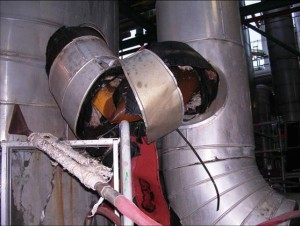Corrosion under insulation (CUI) is a special form of external corrosion, it refers the corrosion of piping and vessels that occurs beneath insulation following water ingression. CUI is difficult to detect until the insulation is removed for inspection or when corrosion damage leads to the failure or leaks. CUI is a major common problem across the oil and gas industry. CUI has been responsible for many major leaks that leads to health and safety incidents results in lost production and are responsible for the large maintenance budget to mitigate the problem. Upon to the difference of piping and vessels materials, there are two types of CUI of concern:
Upon to the difference of piping and vessels materials, there are two types of CUI of concern:
- Oxygen corrosion
For carbon steel and low alloy steel, oxygen corrosion with water ingression is a primary mechanism. In this situation, water or moisture must be present on the substrate in order to allow oxygen corrosion to occur. Water ingression is due to breaks in the insulation, cladding or jacketing, which could be a consequence of poor installation, damage and deterioration.
- Stress Corrosion Cracking (SCC)
For Austenite and duplex stainless steel, chloride external stress corrosion cracking is the primary mechanism. In this situation, chloride may invade with water ingression. In some case, chloride may also leach from the insulation materials.
There are couple of commonly accepted guidelines to define the probability of CUI. For example, “European Federation of Corrosion Publications (55) Corrosion-Under-Insulation (CUI ) Guidelines” (EFC55)suggested:
- Carbon Steel operates continuously between -4~175oC
- Austenitic Stainless Steel continuously operate between 50~175oC
- Intermittent operation at any temperature range
may suffer with the CUI issues. This is in line with NACE SP0198 “Control of Corrosion Under Thermal Insulation and Fireproofing Materials—A Systems Approach” (NACE, 2010). However, API RP583 ballot version”Corrosion Under Insulation and Fireproofing” seems to take broader temperature range in regards to CUI susceptibility (API 2012).
